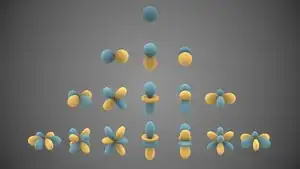My question arises as the moment of inertia (MOI) has been described as a second moment. In my understanding if the MOI is indeed a second moment of a distribution of mass, this suggests the MOI could be interpreted as the variance in the distribution of mass about a particular axis and more interesting interpretations could be drawn from higher moments. However, I have not been able to find any definitive evidence that the MOI is indeed the second central moment of a distribution that describes the location of mass in a body.
(Q1) What is the connection between the second moment of the spatial distribution of mass and the MOI?
Moreover, a basic example leads to more questions than answers.
Example 1: Consider the following definition for the MOI, $I$, about an axis containing the center of mass, $$I = \int\limits_{m}r^2 \mathop{dm}\quad\quad(1)$$ where $r$ is the distance from the axis to the infinitesimal mass, $\mathop{dm}$.
For a thin disc of uniform density characterized by radius $R$ and height $H$ (with $H \ll R$), the MOI about the axis $z$ (taken to be the axis of rotational symmetry) follows from elementary manipulations of the differential mass element, $$\mathop{dm} = \rho \mathop{dV} = \frac{M}{\pi R^2 H} r\mathop{dr}\mathop{d\theta}\mathop{dz}.\quad\quad(2) $$ Then, the MOI of the disc about $z$, $I_z$ is simply, $$ I_z = \int\limits_{-H/2}^{H/2}\int\limits_{0}^{2\pi}\int\limits_{0}^{R} r^2 \frac{M}{\pi R^2 H} r\mathop{dr}\mathop{d\theta}\mathop{dz} = \frac{M}{2}R^2. \quad\quad(3) $$
In mathematics, the $n$th central moment, $\mu_{n}$, of a probability density function of a single variable is given by $$\mu_{n} = \int_{-\infty}^{\infty}(x - \mu_{1}^{'})^{n} f(x)\mathop{dx} \quad\quad(4) $$ where $\mu_{1}^{'}$ indicates the first raw moment of the distribution.
Returning to the example and assuming (A1) $I_z = \mu_{2}$ and (A2) $c = 0$ as the ''first moment (normalized by total mass) is the center of mass'' [1] and the center of mass (COM) intuitively lies at ($0$, $0$, $0$) in the (cartesian) principal axis frame, the probability density of the mass, $f(r)$, follows as $$ f(r) = \frac{2Mr}{R^2} \quad\quad(5) $$ where the factor of $2\pi H r$ associated with the differential volume element has been absorbed into $f$. Verifying the total mass is indeed the first moment gives, $$ M = \int_{0}^{R}f(r) \mathop{dr} = \frac{2M}{R^2}\left(\frac{R^2}{2}\right) = M, \quad\quad(6) $$
but verification of the COM via calculation uncovers an inconsistency with (A2),$$ \mu_{1}^{'} = \int_{0}^{R} r f(r) dr=\frac{2MR}{3} \neq 0. \quad\quad(7) $$In my understanding, this result would indicate the average value of $r$ for the probability density defined earlier is $2MR/3$. I suspect this could be occurring because of the use of cylindrical coordinates, but I have a feeling that there is something else wrong (potentially with needing an expression for the $n$th moment of a multivariate distribution which would enable the use of cartesian coordinates with $f(x, y)$).After considering @Tristan's answer, I think Equation (7) more appropriately captures the average distance of mass from the $z$-axis rather than a component of the COM vector.(Q1.1) Is the previous statement a correct interpretation of Equation (7)?
(Q1.2) It appears that the components of the MOI tensor and the COM vector are found by averaging about different combinations of coordinates. For example,
Example 2: The $x$ component of the COM vector is given by $$ x_{\text{COM}} = \iiint x' f(x',y',z')\mathop{dx'}\mathop{dy'}\mathop{dz'} $$ where $x'$ indicates the $x$-coordinate in the lab frame.
Is there a physically relevant quantity that would correspond to a marginalization about a particular axis? (In Example 1 it would appear that $f(r)$ is a marginalization about the $\theta$ and $z$ -axis and corresponds to the distribution of mass about the $z$-axis, though I suspect there could be something more interesting for higher order moments or averaging over other quantities.)
(Q2) What is the general form for the moments of a 3D mass distribution (e.g., $f(x, y, z)$ or $f(\mathbf{r})$) that includes the MOI about an arbitrary axis as special cases for the second moment?
(Q3) While David Z.'s comments on this post are close to what I am looking for, I have not been able to find another resource to verify his general expression and I am having considerable difficulty relating it to the basic example indicated here. Could you please point me to a reference on higher-order moments of multivariate distributions (potentially in the context of mass distributions)?
